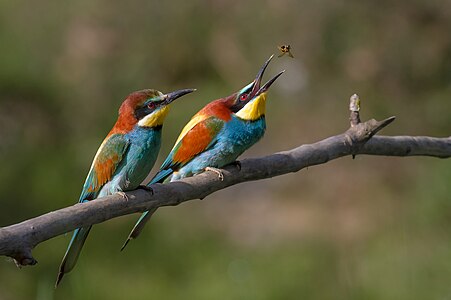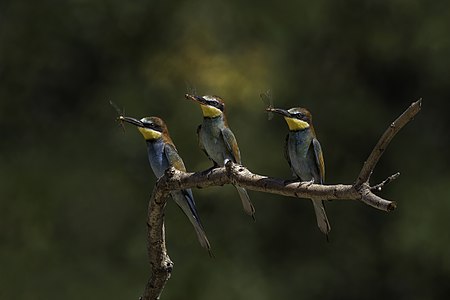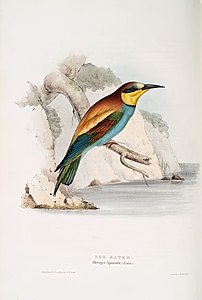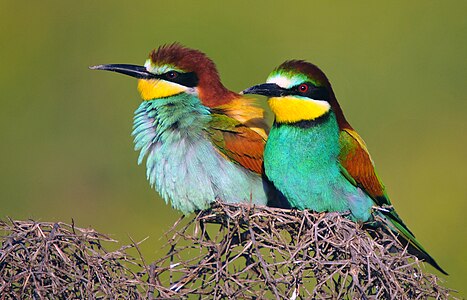European bee-eater
| European bee-eater | |
|---|---|

| |
| Scientific classification | |
| Domain: | Eukaryota |
| Kingdom: | Animalia |
| Phylum: | Chordata |
| Class: | Aves |
| Order: | Coraciiformes |
| Family: | Meropidae |
| Genus: | Merops |
| Species: | M. apiaster
|
| Binomial name | |
| Merops apiaster | |

| |
| Distribution of Merops apiaster | |
The European bee-eater (Merops apiaster) is a near passerine bird in the bee-eater family, Meropidae. It breeds in southern and central Europe, northern and southern Africa, and western Asia. Except for the resident southern African population, the species is strongly migratory, wintering in tropical Africa.[1] This species occurs as a spring overshoot north of its usual range, with occasional breeding in northern Europe.
Taxonomy and systematics
[edit]The European bee-eater was formally described by the Swedish naturalist Carl Linnaeus in 1758 in the tenth edition of his Systema Naturae under its current binomial name Merops apiaster.[2] The genus name Merops is Ancient Greek for "bee-eater", and apiaster is Latin, also meaning "bee-eater", from apis, "bee".[3]
Description
[edit]This species, like other bee-eaters, is a richly coloured, slender bird. It has brown and yellow upper parts, whilst the wings are green and the beak is black. It can reach a length of 27–29 cm (10.6–11.4 in), including the two elongated central tail feathers. Sexes are alike. Female tends to have greener rather than gold feathers on shoulders. Non-breeding plumage is much duller and with a blue-green back and no elongated central tail feathers. Juvenile resembles a non-breeding adult, but with less variation in the feather colours. Adults begin to moult in June or July and complete the process by August or September. There is a further moult into breeding plumage in winter in Africa.[4]
Behaviour and ecology
[edit]Breeding
[edit]
These bee-eaters are gregarious—nesting colonially in sandy banks, preferably near river shores, usually at the beginning of May. They make a relatively long tunnel, in which they lay five to eight spherical white eggs around the beginning of June. Both male and female care for the eggs, which they brood for about three weeks. They also feed and roost communally.
During courtship, the male feeds large items to the female while eating the small ones himself.[5] Most males are monogamous, but occasional bigamy has been encountered.[6] Their typical call is a distinctive, mellow, liquid and burry prreee or prruup.
Feeding
[edit]This bird breeds in open country in warmer climates. As the name suggests, bee-eaters predominantly eat insects, especially bees, wasps, and hornets. They catch insects in flight, in sorties from an open perch. Before eating a bee, the European bee-eater removes the sting by repeatedly hitting the insect on a hard surface. It can eat around 250 bees a day.[citation needed]
The most important prey item in their diet is Hymenoptera, mostly the European honey bee. A study in Spain found that these comprise 69.4% to 82% of the European bee-eaters' diet.[7] Their impact on bee populations, however, is small. They eat less than 1% of the worker bees in areas where they live.[8]
A study found that European bee-eaters "convert food to body weight more efficiently if they are fed a mixture of bees and dragonflies than if they eat only bees or only dragonflies."[9]
-
Feeding bee-eater—the female (in front) waits for the male's offering
-
Each with a dragonfly
Predation of honey bees
[edit]
If an apiary is set up close to a bee-eater colony, a larger number of honey bees are eaten because they are more abundant. However, studies show the bee-eaters do not intentionally fly into the apiary, rather they feed on the insects caught on pastures and meadows within a radius of 12 km (7.5 mi) from the colony, this maximum distance being reached only when there is a lack of food. Observations show that the birds actually enter the apiary only in cold and rainy periods, when the bees do not leave the hive and other insect prey are harder for the bee-eaters to detect.[10]
Many bee-keepers believe that the bee-eaters are the main obstacle causing worker bees not to forage, and instead stay inside the hives for much of the day between May and the end of August. However, a study carried out in eucalyptus forest in the Alalous region, 80 km (50 mi) east of Tripoli, Libya, showed that the bee-eaters were not the main obstacle of bee foraging, which is the opposite of what beekeepers think. The foraging rate was higher in presence of the birds than in their absence in some cases. The average bird meal consisted of 90.8% honey bees and 9.2% beetles.[11]
Predation is more likely when the bees are queening or during peak migrations, from late March till mid-April, and in mid-September. Hives close to or under trees or overhead cables are also at increased risk as the birds pounce on flying insects from these perches.[12]
Gallery
[edit]-
Stamp of Moldova -European bee-eater
-
European bee-eater painted by John Gould, English ornithologist
-
A pair of Turkish bee-eaters
-
ID composite
-
Close-up video of a female European bee-eater
See also
[edit]References
[edit]- ^ a b BirdLife International (2019) [amended version of 2016 assessment]. "Merops apiaster". IUCN Red List of Threatened Species. 2019: e.T22683756A155512816. doi:10.2305/IUCN.UK.2016-3.RLTS.T22683756A155512816.en. Retrieved 12 November 2021.
- ^ Linnaeus, Carl (1758). Systema Naturae per regna tria naturae, secundum classes, ordines, genera, species, cum characteribus, differentiis, synonymis, locis (in Latin). Vol. 1 (10th ed.). Holmiae:Laurentii Salvii. p. 117.
- ^ Jobling, James A (2010). The Helm Dictionary of Scientific Bird Names. London: Christopher Helm. pp. 50, 251. ISBN 978-1-4081-2501-4.
- ^ RSPB Handbook of British Birds (2014). UK ISBN 978-1-4729-0647-2.
- ^ Avery, MI; Krebs, JR; Houston, AI (1988). "Economics of courtship-feeding in the European bee-eater (Merops apiaster)". Behavioral Ecology and Sociobiology. 23 (2): 61–67. Bibcode:1988BEcoS..23...61A. doi:10.1007/BF00299888. S2CID 13553144.
- ^ Avery, MI; Krebs, JR; Hegner, RE (1984). "A Case of Bigamy in the European Bee-Eater (Merops apiaster)". The Auk. 101 (3): 609–610. doi:10.1093/auk/101.3.609. S2CID 89508037.
- ^ Higes, Mariano; Martín-Hernández, Raquel; Garrido-Bailón, Encarna; Botías, Cristina; García-Palencia, Pilar; Meana, Aránzazu (2008). "Regurgitated pellets of Merops apiaster as fomites of infective Nosema ceranae (Microsporidia) spores". Environmental Microbiology. 10 (5): 1374–1379. Bibcode:2008EnvMi..10.1374H. doi:10.1111/j.1462-2920.2007.01548.x. PMID 18218034.
- ^ Roulston, TH; Goodell, K (2011). "The role of resources and risks in regulating wild bee populations". Annual Review of Entomology. 56: 293–312. doi:10.1146/annurev-ento-120709-144802. PMID 20822447.
- ^ Judith Goodenough; Betty McGuire; Elizabeth Jakob (2009). Perspectives on Animal Behavior. John Wiley & Sons. p. 268. ISBN 978-0-470-04517-6.
- ^ "Prigonirea prigoriei. [Myths and truths about honey bees and bee eaters ]" (in Romanian). Romanian Ornithological Society. Archived from the original on 2018-06-27. Retrieved 2018-06-27.
- ^ Alfallah, H.M. "The impact of the Bee-eater Merops apiaster on the behavior of honey bee Apis mellifera L. during foraging" (PDF). Mansoura Journal of Plant Protection and Pathology, 1(12): 1023-1030. Archived from the original (PDF) on 2018-06-27. Retrieved 2018-06-27.
- ^ Carabott, Sarah (2015-10-26). "Bee-eater is not to blame for decline in honey bees". Times of Malta. Valletta, Malta. Retrieved 2018-06-27.
External links
[edit]- European bee-eater videos, photos & sounds on the Internet Bird Collection
- European bee-eater species text in The Atlas of Southern African Birds.
- Audio recordings of European bee-eater on Xeno-canto.
- Guêpier d'Europe Merops apiaster - European Bee-eater—Photos at Oiseaux.net
- Feathers of European bee-eater (Merops apiaster) Archived 2018-03-04 at the Wayback Machine
- Ageing and sexing by Javier Blasco-Zumeta & Gerd-Michael Heinze Archived 2016-11-08 at the Wayback Machine (PDF; 5.4 MB)








